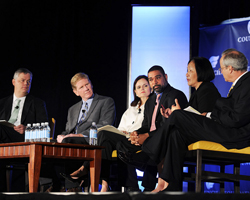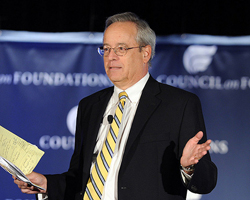A Balancing Act Plenary Highlights
Panelists Say Long Recovery Will Challenge Community Foundations

Community foundations will face an unsettled period in the next five to 10 years. With the economy struggling to right itself, some may find they need to invest even more time, manpower, and resources than they originally thought. During the conference’s closing plenary session, a panel debated whether and how community foundations will be able to sustain local programs as the nation struggles to recover.
Sparks flew when Stuart Rothenberg, editor and publisher of The Rothenberg Political Report, took to the stage alongside Colin Lacon, president and CEO of Northern California Grantmakers; Richard Ober, president and CEO of the New Hampshire Charitable Foundation; Clotilde Perez-Bode Dedecker, president and CEO of the Community Foundation for Greater Buffalo; and Andrew Schulz, the Council’s vice president of legal and government relations. The group discussed how community foundations are extra vulnerable to economic and political shifts, despite their passion, missions, and dedicated followers. Even as budgets are being sliced, community foundations are struggling to keep their missions at the forefront of donors’ minds as the great grapple for funding continues to be a full-contact undertaking.
 One observer of the session, Henry Izumizaki, CEO of the One Nation Foundation and strategic adviser to The Russell Family Foundation, noted in a RE: Philanthropy blog post: “Community foundations... are facing not only tighter grantmaking budgets but shorter tempers in their communities because of the greater polarization the country is experiencing.”
One observer of the session, Henry Izumizaki, CEO of the One Nation Foundation and strategic adviser to The Russell Family Foundation, noted in a RE: Philanthropy blog post: “Community foundations... are facing not only tighter grantmaking budgets but shorter tempers in their communities because of the greater polarization the country is experiencing.”
The discussion during the closing plenary—really, during all of the plenary sessions—is exactly what conference chair Nicole Taylor, president and CEO of the East Bay Community Foundation, envisioned when she and her colleagues shaped content for this year’s gathering. “From the very beginning when the planning committee met, we wanted people to feel engaged, to feel like it was worth their time and money to attend. We wanted them to be not only informed about issues and catch some exciting ideas but to take tangible actions when they got back home,” she said.
“We wanted people’s thoughts to be provoked, we wanted people to challenge assumptions, talk about how they’re doing things, how the field is moving. And we wanted to infuse innovation so that people would get out of their comfort zone a little,” she added. Mission accomplished.


